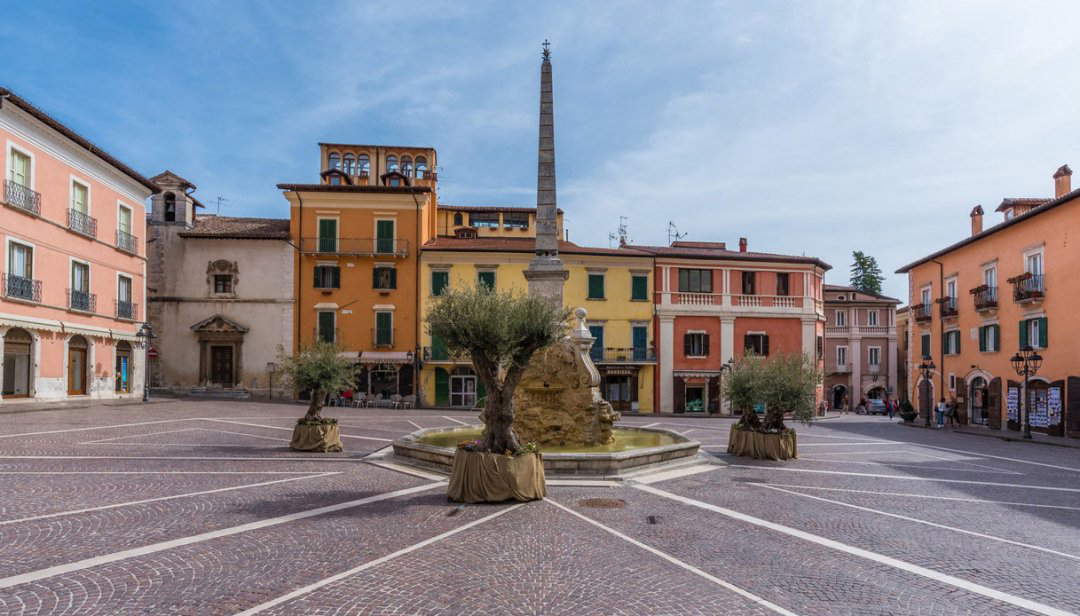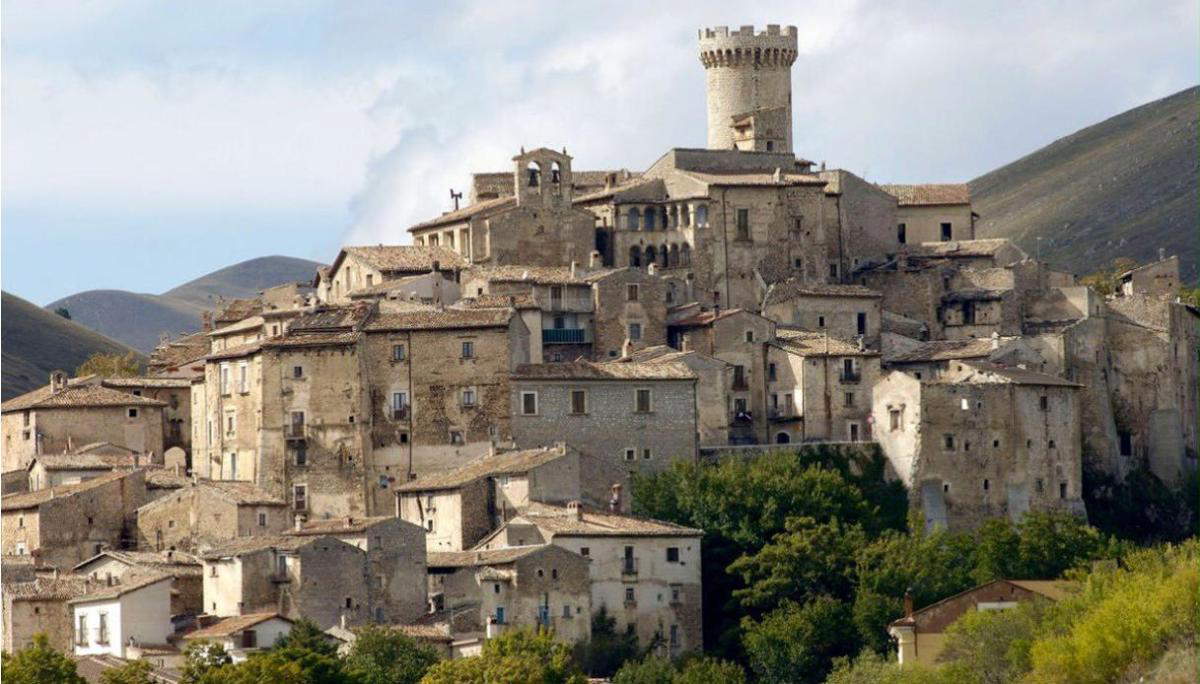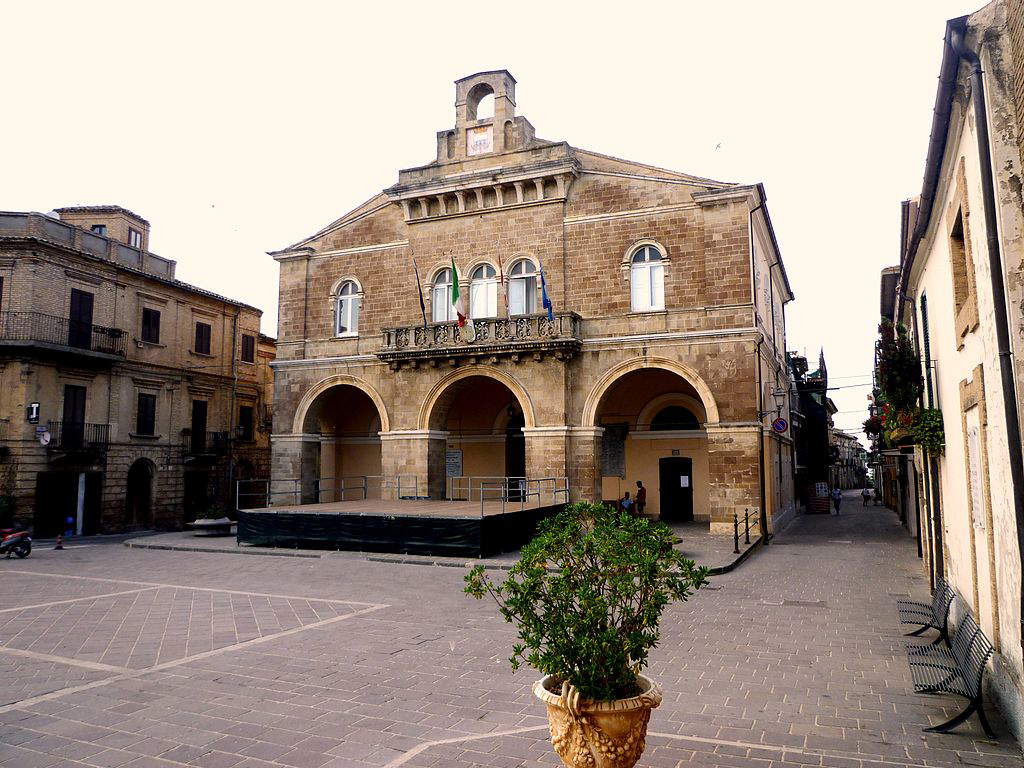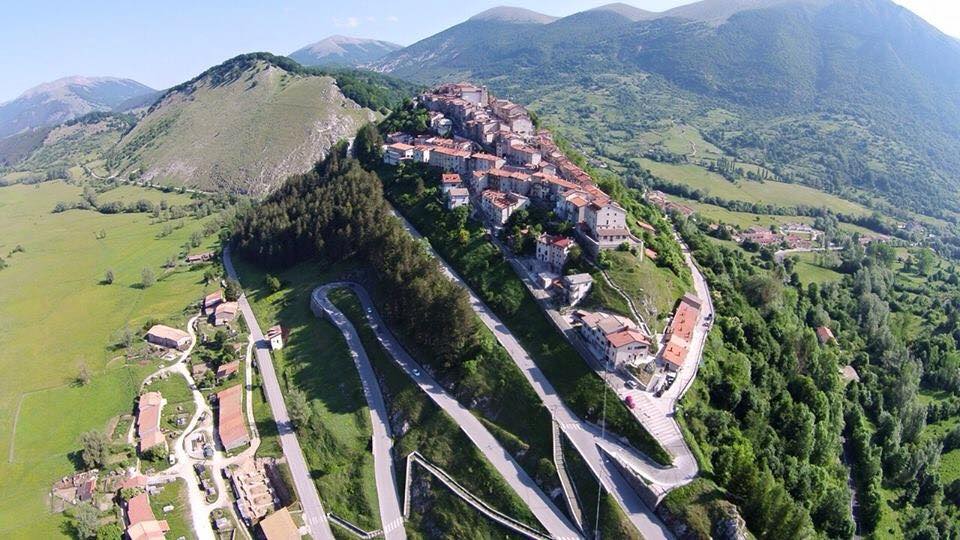1. Pacentro
The earliest records of Pacentro date back to the 8th century, but most of the monuments that distinguish it today date back to the period between the 13th and 15th centuries, that is, to the so-called “caldoresque period,” when Pacentro, along with several other towns in Abruzzo and Molise, was a fief of the powerful Caldora family, one of the most illustrious families of the Kingdom of Naples. During these years arose the fortifications that are symbolic of the village: the Caldora Castle, in particular, was built between the end of the 14th and the beginning of the 15th century; it has suffered greatly from the action of time but its structure has been preserved and can be visited today. Another landmark building is the parish church of Santa Maria Maggiore, also from the 15th century, but with a facade from a later century. A curiosity: Pacentro is the homeland of pop star Madonna (her paternal grandparents were in fact born here).
 |
| View of Pacentro. Ph. Credit |
2. Popoli
Rising on the banks of the Pescara River, on the last foothills of the Abruzzo Apennines: its origins are Roman (a village called Pagus Fabianus stood in this area), and it was probably abandoned after the barbarian invasions. The new village was formed in the 9th century: it was a village near the abbey of San Clemente a Casauria, known as Castrum Pauperum. In contrast, the construction of the first castle most likely dates to the next century. Popoli developed mainly in the 13th century, when it became a fief of the Cantelmo family, rivals of the aforementioned Caldora, and who remained feudal lords of Popoli until 1749. The Cantelmo Castle is still there: it occupies the top of a mountain overlooking the village. The ancient residence of the family is the 15th-century Cantelmo Ducal Palace. From the same period is the church of San Francesco, which, however, is now in its late Baroque appearance (inside there is an interesting majolica antependium from Castelli, a locality not far away). Late Baroque is also the scenic Church of the Holy Trinity. Near the village is also the Sorgenti del Pescara Nature Reserve, a reserve of great scenic interest.
 |
| View of Popoli. Ph. Credit |
3. Penne
The town, a few kilometers from the sea, stands on four hills (represented in the municipality’s coat of arms by the four towers) and is of ancient origin: the ancient Roman name Pinna Vestinorum indicates that it was founded by the Vestini, an ancient local population. In Roman times it was one of the most important cities on this stretch of the Adriatic coast, and in the Middle Ages it was Norman, Swabian and Angevin, and in 1522 it became a personal fief of Alessandro de’ Medici and then of Margaret of Austria, who married Ottavio Farnese (Penne was thus a Farnese fief for almost two centuries). A famous episode in the history of the village is the uprising against the Kingdom of Naples that broke out in 1837 and went down in history as the “insurrection of the Pennese martyrs”: an obelisk in town commemorates it. The town is developed around the cathedral, which is also the co-cathedral of the archdiocese of Pescara-Penne: its present appearance, in pseudo-Romanesque style, is due to postwar restorations, but ancient works are preserved inside. Numerous eighteenth-century buildings of worship line the entire village, alternating with Renaissance and Baroque palaces. Penne is also home to a Diocesan Civic Museum, an Archaeological Museum, a Natural History Museum, and a new Museum of Modern and Contemporary Art, opened in 2010.
 |
| Penne, the entrance to the medieval village |
4. Tagliacozzo
The episode we have all read about in history books is the famous battle of Tagliacozzo, which was fought in 1268 between Conradin of Swabia and Charles I of Anjou, and was decisive (as well as one of the most important events of the Middle Ages) in that it awarded the Angevins the Kingdom of Sicily. The main center of Marsica, Tagliacozzo began to form in the 11th century: it was therefore a feud of the Orsini family until the end of the 15th century, when Tagliacozzo became a feud of the Colonna family, who held the fief until 1806, the date feudalism was abolished. Traces of the two families can be found in the streets of the town: the Ducal Palace was the residence first of the Orsini (who had it built) and then of the Colonna family, the church and convent of San Francesco (the church retains the Gothic style) developed thanks to their donations, and the same is true of the church of Santa Maria del Soccorso, while the church of Santi Cosma e Damiano preserves the painting of the Holy Face that the Colonna family donated to the town. The Oriental Museum houses an interesting collection of Egyptian, Oriental and Middle Eastern art. Finally, Tagliacozzo is also a starting point for nature excursions in the Marsica area.
 |
| Tagliacozzo, Obelisk square |
5. Santo Stefano di Sessanio
A small town of just 115 inhabitants in the Abruzzo Apennines, it has medieval origins: it is first attested in 1239, but the history of Santo Stefano di Sessanio presumably begins a few centuries earlier. Until 1806 it was part of the barony of Carapelle, but it reached its peak development in the 16th century, when the Medici took possession of the barony and gave a major economic boost to the area and the village, which became a thriving center of the wool trade. Today, the village, which lies on the slopes of the Gran Sasso, is still largely in its medieval appearance. Santo Stefano di Sessanio is dominated by the Medicean Tower (collapsed in the 2009 L’Aquila earthquake; it is currently being rebuilt) and is home to interesting buildings such as the 18th-century church of Santo Stefano Martire (which has older origins, however: the portal is in fact Romanesque), the Medici Palace, and the church of Madonna del Lago.
 |
| View of Santo Stefano di Sessanio |
6. Rocca San Giovanni
It sits on a hill overlooking the Trabocchi coast, so named because of the presence of the “trabocchi,” the piles that Abruzzo fishermen have used for centuries to fish in the Adriatic Sea. It was founded in the 11th century by the abbots of the monastery of San Giovanni in Venere, which is located not far away in the municipal territory of Fossacesia, and began as a small fortified village. Repeatedly devastated by earthquakes, it nevertheless has valuable ancient monuments (as well as an urban fabric that has not undergone substantial changes since the 14th century): the medieval walls, the Torrione dei Filippini, and the church of San Matteo, which has nevertheless been remodeled several times over the centuries. The Town Hall, on the other hand, dates back to the 19th century. Rocca San Giovanni also has a number of hamlets on the sea, and in the municipal territory is also the Rocca San Giovanni Wildlife Area, a large zoo-safari, the only park of its kind in the entire region.
 |
| Rocca San Giovanni, the town hall. Ph. Credit |
7. Opi
It is a village of four hundred inhabitants clinging to the crest of a mountain, in Marsica. Opi is first attested in the 11th century, and was a fief of numerous families that succeeded each other down the centuries. For centuries Opi’s economy was based on sheep farming: the sobriety of its historic center is a reminder of this vocation. In the village the church of Santa Maria Assunta and the church of San Giovanni Battista are worth seeing, while in the surrounding area it is possible to explore the Abruzzo, Lazio and Molise National Park, one of the oldest in Italy, of which Opi is one of the main centers.
 |
| View of Opi. Ph. Credit Carlo Di Rocco |
8. Barrea
It is located not far from Opi, in the Alto Sangro territory, and rises at an altitude of 1,000 meters near the banks of the artificial lake of the same name (it was created in 1951 when the Sangro was dammed for the purpose of electricity production), in one of the most enchanting landscape areas of Abruzzo. There were probably Samnite and Roman settlements here, but the present village was probably born in the 11th century at the behest of the abbots of Montecassino. It was then a feud of many families who succeeded each other in the administration of the area (the Di Sangro, Caldora, D’Afflitto, and Caracciolo families, with the latter holding it until 1806). Barrea was devastated during World War II: in fact, it was located not far from the Gustav Line. Barrea’s medieval origin is recalled by the castle built between the 11th and 12th centuries by the Di Sangro family: also worth visiting are the 14th-century church of St. Thomas (long remodeled over the centuries), the church of Madonna delle Grazie, and the monastery of St. Michael the Archangel.
 |
| View of Barrea. Ph. Credit |
9. Atri
Located not far from the coast, it is a center of very ancient origins, founded perhaps as early as the Piceni, flourishing in Roman times (indeed: it was one of the most important cities in the area). It revived in the 14th century after a centuries-long period of decline that followed the fall of the Roman empire, and developed in the 15th century, when it became a fief of the Acquaviva family, who held it until well into the 18th century, leaving their indelible imprint. The symbol of the town is the splendid cathedral, built between the thirteenth and fourteenth centuries, which preserves many valuable works of art (the spectacular choir frescoed by Andrea De Litio is not to be missed), and then the eighteenth-century church of San Francesco, the Romanesque church of San Nicola, which preserves its medieval appearance intact, the Palace of the Acquaviva dukes (also known as the Ducal Palace, it was the residence of the local feudal lords and is now the town hall of Atri), and the cyclopean walls dating from the sixth century BC, are all worth seeing. Atri is also home to several museums: the Capitular Museum (which includes a visit to the cloister of the cathedral), the Civic Ethnographic Museum, the Archaeological Museum, and the Educational Museum of Medieval and Renaissance Musical Instruments (located in the Ducal Palace).
 |
| The cathedral of Atri. Ph. Credit |
10. Guardiagrele
Guardiagrele is home to the Majella National Park and arose in the 7th century as a Lombard outpost, while the present village began to take on its present appearance between the 12th and 14th centuries. During the Middle Ages, the goldsmith tradition developed in Guardiagrele, reaching its peak in the figure of Nicola da Guardiagrele, a great goldsmith who lived between the 14th and 15th centuries. The history of the village is marked by the tragedy of the French siege of 1799, when 328 villagers died under the attack of General Coutard’s troops. Heavily bombed during World War II, it was later rebuilt and managed to recover after the war. Its historic center has numerous monuments: among the oldest are the Orsini Tower, the medieval collegiate church of Santa Maria Maggiore, the 13th-century church of San Francesco, and the church of San Nicola, which is perhaps the oldest in the town, although tried by the centuries. The main civic building, however, is Palazzo Vitacolonna, which has an elegant neo-Renaissance facade. Guardiagrele is also one of the main centers for learning about Abruzzo traditions: the Museum of Costume and Tradition of Our People, the Museum of Abruzzo Artistic Crafts, and the Museum of Costume and Folk Tradition are dedicated to them. Works of art and archaeological finds are preserved in the Cathedral Museum and the “Filippo Ferrari” Archaeological Museum. Finally, Guardiagrele is one of the towns in which one of Abruzzo author Gabriele D’Annunzio’s masterpieces, The Triumph of Death, is set.
 |
| Guardiagrele, Santa Maria Maggiore. Ph. Credit |
 |
| Ten villages to visit in Abruzzo |
Warning: the translation into English of the original Italian article was created using automatic tools. We undertake to review all articles, but we do not guarantee the total absence of inaccuracies in the translation due to the program. You can find the original by clicking on the ITA button. If you find any mistake,please contact us.